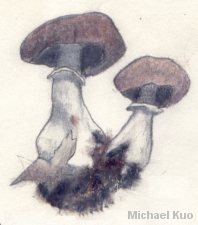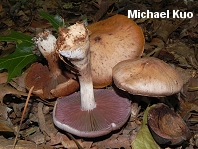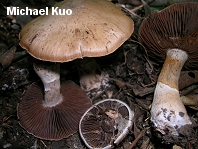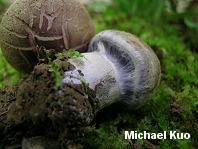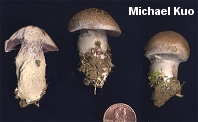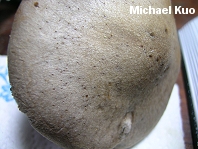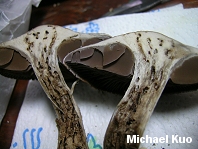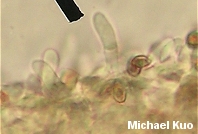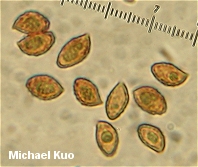| Major Groups > Gilled Mushrooms > Dark-Spored > Cortinarius > Cortinarius torvus |

|
Cortinarius torvus [Basidiomycetes > Agaricales > Cortinariaceae > Cortinarius ... ] by Michael Kuo This stinky, booted, hardwood-loving schmuck of a Cortinarius was originally named from Europe's beech forests. It features a variable lilac brown cap, purplish and well spaced gills, a white "boot" sheathing the stem (often forming a turned-over ring), as well as a sickly sweet odor. In North America we seem to have at least two mushrooms that potentially qualify as "Cortinarius torvus"--a northern, beech-maple associate (illustrated by the drawing--yes, that's crayon--I made many years ago in northern Michigan) that appears in the fall, and a more southerly, oak-associated species with a more unpleasant odor (illustrated by the photos), appearing in spring and summer. Description: Ecology: Mycorrhizal with hardwoods, including beech and both red and white oaks; growing scattered to gregariously; spring, summer, and fall; probably widely distributed in eastern North America. Cap: 3-8 cm; convex or irregular at first, becoming broadly convex, broadly bell-shaped, or nearly flat; dry; very finely silky or, in age, nearly bald; quite variable in color but generally lilac brown when young, fading markedly as it dries out to grayish lilac (often reminiscent of Lactarius argillaceifolius) or silvery--and eventually to a wishy-washy tan; the margin inrolled well into maturity. Gills: Attached to the stem; nearly distant; brownish purple when young, becoming rusty brown; covered by a whitish cortina when young. Stem: 4-10 cm long; up to 1.5 cm thick at the apex; tapering to a club-shaped, swollen base; dry; pale purple above when fresh and young but later silvery to whitish or faintly brownish; sheathed or "booted" from the base with whitish to lilac gray veil material that often terminates in a folded-over, fragile ring. Flesh: Whitish, or with purple to gray shades in the stem. Odor: Strong and sickly sweet. Chemical Reactions: KOH negative to gray on cap; grayish to gray on flesh. Spore Print: Rusty brown. Microscopic Features: Spores 8-11.5 x 4.5-6 µ; ellipsoid, with a narrowed apicular end; weakly to moderately verrucose. Cheilo- and pleurocystidia absent, but subclavate, septate marginal cells present on gill edges. Pileipellis a cutis of hyaline to brownish, occasionally encrusted elements. REFERENCES: (Fries, 1818) Fries, 1838. (Fries, 1821; Saccardo, 1887; Smith, Smith & Weber, 1979; Moser, 1983; Phillips, 1986; Phillips, 1991/2005; Hansen & Knudsen, 1992; Breitenbach & Kränzlin, 2000; McNeil, 2006.) Herb. Kuo 07280406, 08310505, 05170702, 07160707, 09260801, 06241101, 07141104. This site contains no information about the edibility or toxicity of mushrooms. |
© MushroomExpert.Com |
|
Cite this page as: Kuo, M. (2011, December). Cortinarius torvus. Retrieved from the MushroomExpert.Com Web site: http://www.mushroomexpert.com/cortinarius_torvus.html |
